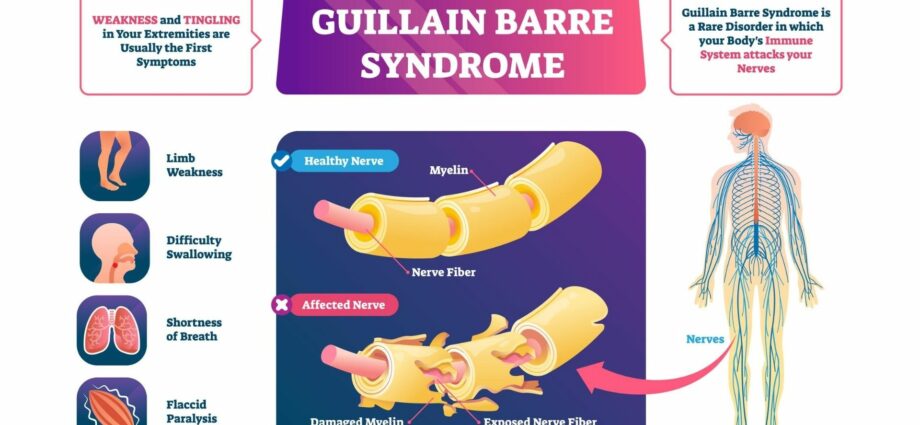Inhalter
Guillain-Barré Syndrom
Wat ass et ?
Guillain-Barré syndrome (GBS), or Acute Inflammatory Polyradiculoneuritis, is an autoimmune disease that causes peripheral nerve damage and paralysis. This paralysis is said to be extensive because it generally begins with the legs and arms and then spreads to the rest of the body. There are many causes, but the syndrome most often occurs after infection, hence its other name of acute postinfectious polyradiculoneuritis. Each year in France, 1 to 2 people in 10 are affected by the syndrome. (000) The majority of affected people recover completely within a few months, but the syndrome can leave significant damage and, in rare cases, lead to death, most often by paralysis of the respiratory muscles.
d`Situatioun
Tingling and foreign sensations appear in the feet and hands, often symmetrically, and spread to the legs, arms and the rest of the body. The severity and course of the syndrome vary widely, from simple muscle weakness to paralysis of certain muscles and, in severe cases, almost total paralysis. 90% of patients experience maximum general damage during the third week following the first symptoms. (2) In severe forms, the prognosis is life-threatening due to damage to the muscles of the oropharynx and respiratory muscles, posing the risk of respiratory failure and stoppage. The symptoms are quite similar to those of other conditions such as botulism ((+ link)) or Lyme disease.
D'Originne vun der Krankheet
Following infection, the immune system produces autoantibodies that attack and damage the myelin sheath surrounding the nerve fibers (axons) of the peripheral nerves, preventing them from transmitting electrical signals from the brain to the muscles.
The cause of Guillain-Barré syndrome is not always identified, but in two-thirds of cases it occurs a few days or weeks after diarrhea, lung disease, flu … Infection by the bacteria Campylobacter (responsible for intestinal infections) is one of the main risk factors. Much more rarely, the cause may be vaccination, surgery, or trauma.
Risiko Facteure
The syndrome affects men more frequently than women and adults than children (the risk increases with age). Guillain-Barré syndrome is neither contagious nor hereditary. However, there could be genetic predispositions. After much controversy, researchers have successfully confirmed that Guillain-Barré syndrome can be caused by infection with the Zika virus. (3)
Präventioun a Behandlung
Two immunotherapy treatments are effective in stopping the damage to the nerves:
- Plasmapheresis, which consists of replacing the blood plasma containing the autoantibodies that attack the nerves with healthy plasma.
- Intravenous injection of antibodies (intravenous immunoglobulins) which will neutralize autoantibodies.
They require hospitalization and will be all the more effective if they have been implemented early enough to limit damage to the nerves. Because when the nerve fibers protected by the myelin sheath are themselves affected, the sequelae become irreversible.
Special attention should be paid to irregularities in breathing, heart rate and blood pressure, and the patient should be placed on assisted ventilation if paralysis reaches the respiratory system. Rehabilitation sessions may be necessary to recover full motor skills.
The prognosis is generally good and the better the younger the patient. Recovery is complete after six to twelve months in about 85% of cases, but about 10% of affected people will have significant sequelae (1). The syndrome causes death in 3% to 5% of cases according to the WHO, but up to 10% according to other sources. Death occurs from cardiac arrest, or due to complications from prolonged resuscitation, such as nosocomial infection or pulmonary embolism. (4)










